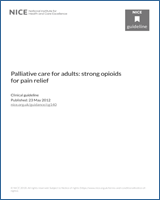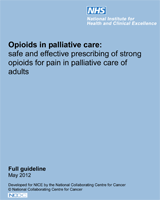NCBI Bookshelf. A service of the National Library of Medicine, National Institutes of Health.
In August 2016, recommendation 1.1.12 was deleted by NICE and a link was added to NICEâs guideline on controlled drugs: safe use and management, which has newer advice on the topic. Two out of date research recommendations have also been deleted.
Excerpt
The 2008 World Cancer Declaration included a target to make effective pain control more accessible. Several key documents highlight the importance of effective pain control, including ‘Improving supportive and palliative care for adults with cancer’ (NICE cancer service guidance 2004), ‘Control of pain in adults with cancer’ (Scottish Intercollegiate Guidelines Network guideline 106), ‘A strategic direction for palliative care services in Wales’ (Welsh Assembly Government 2005) and ‘End of life care strategy’ (Department of Health 2008).
Strong opioids, especially morphine, are the principal treatments for pain related to advanced and progressive disease, and their use has increased significantly in the primary care setting. However, the pharmacokinetics of the various opioids are very different and there are marked differences in bioavailability, metabolism and response among patients. A suitable opioid must be selected for each patient and, because drug doses cannot be estimated or calculated in advance, the dose must be individually titrated. Effective and safe titration of opioids has a major impact on patient comfort. The World Health Organization has produced a pain ladder for the relief of cancer pain; strong opioids are represented on the third level of the three-step ladder.
The guideline will address first-line treatment with strong opioids for patients who have been assessed as requiring pain relief at the third level of the WHO pain ladder. It will not cover second-line treatment with strong opioids where a change in strong opioid treatment is required because of inadequate pain control or significant toxicity.
A number of strong opioids are licensed in the UK. However for pain relief in palliative care a relatively small number are commonly used. This guideline has therefore looked at the following drugs: buprenorphine, diamorphine, fentanyl, morphine and oxycodone. Misinterpretations and misunderstanding have surrounded the use of strong opioids for decades, and these are only slowly being resolved. Until recently, prescribing advice has been varied and sometimes conflicting. These factors, along with the wide range of formulations and preparations, have resulted in errors causing underdosing and avoidable pain, or overdosing and distressing adverse effects. Despite repeated warnings from regulatory agencies, these problems have led on occasion to patient deaths, and resulted in doctors facing the General Medical Council or court proceedings. Additional guidance, including advice on reducing dosing errors with opioid medicines, patient safety incidents arising from medication errors involving opioids and safer use of injectable medicines is available from the National Patient Safety Agency (NPSA).
This guideline will clarify the clinical pathway and help to improve pain management and patient safety. This guideline will not cover care during the last days of life (for example, while on the Liverpool Care Pathway).
Contents
- Introduction
- Patient-centred care
- 1. Recommendations
- 2. Care pathway
- 3. Evidence review and recommendations
- 3.1. Communication
- 3.2. Introduction to first-line treatment
- 3.3. Starting strong opioids – titrating the dose with immediate-release, sustained-release or transdermal patches
- 3.4. First-line maintenance treatment
- 3.5. First-line treatment if oral opioids are not suitable – transdermal patches
- 3.6. First-line treatment if oral opioids are not suitable – subcutaneous delivery
- 3.7. First-line treatment if oral opioids are not suitable – transdermal patch versus subcutaneous delivery
- 3.8. First-line treatment for breakthrough pain in patients who can take oral opioids
- 3.9. Management of constipation
- 3.10. Management of nausea
- 3.11. Management of drowsiness
- 4. Notes on the scope of the guideline
- 5. Implementation
- 6. Other versions of this guideline
- 7. Related NICE guidance
- 8. Updating the guideline
- 9. References
- 10. Glossary and abbreviations
- Appendix A. Contributors and declarations of interests
- Appendix B. List of all research recommendations
- Appendix C. Guideline scope
- Appendix D. How this guideline was developed
- Appendix E. Evidence tables
- Appendix F. Full health economic report
This guideline was developed following the NICE short clinical guideline process. This document includes all the recommendations, details of how they were developed and summaries of the evidence they were based on.

